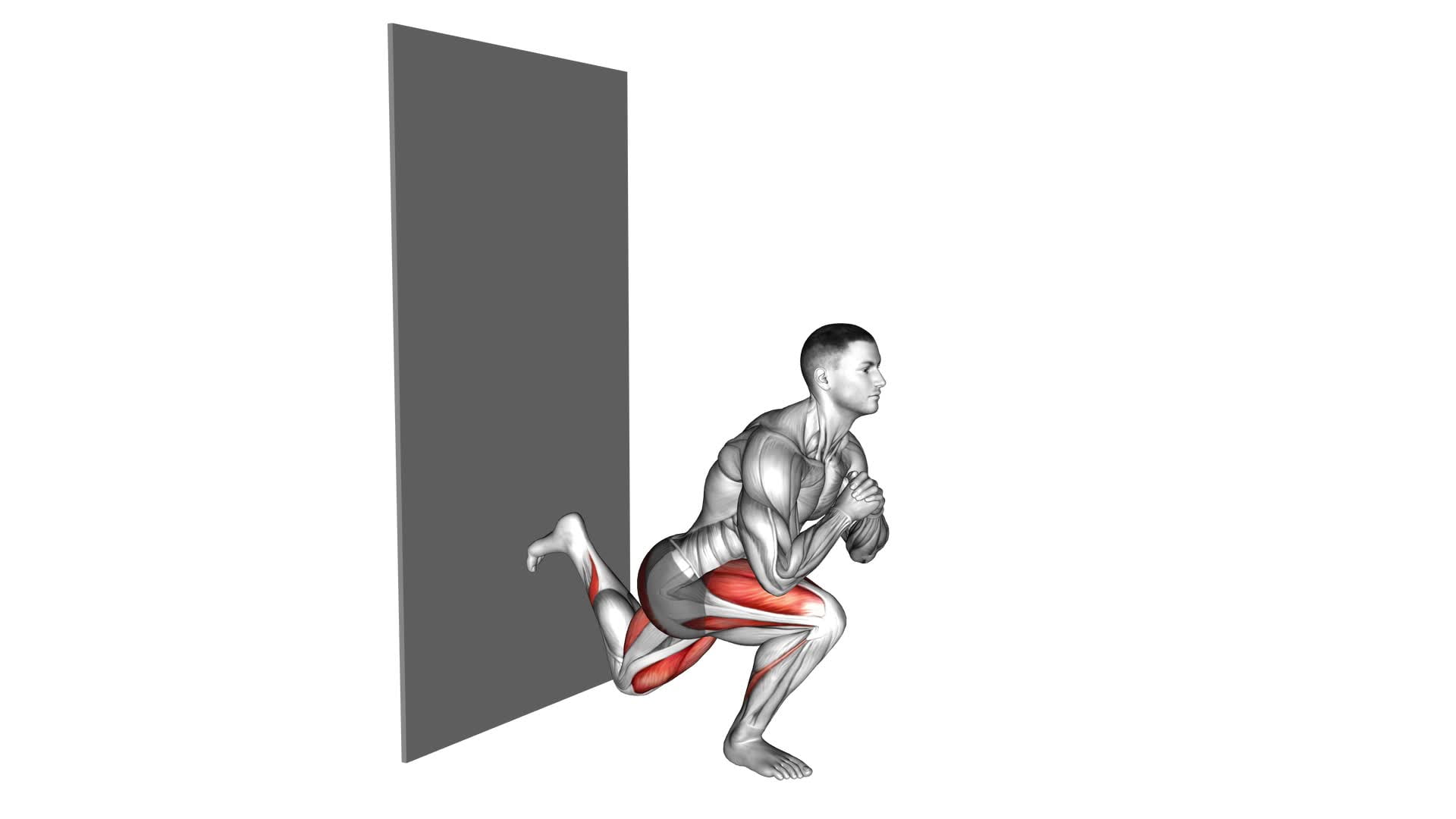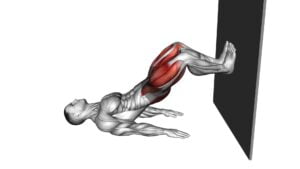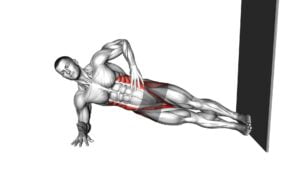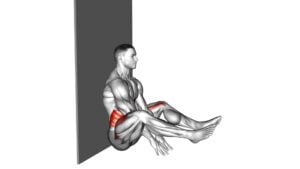Split Squat Against Wall (Male) – Video Exercise Guide & Tips

Looking to amp up your lower body workout? Check out this video exercise guide for the Split Squat Against the Wall.
Watch This Exercise Video
You'll learn the proper form, variations for advanced users, and tips for maximizing results. Avoid common mistakes and prevent injury with our helpful tips.
Get ready to challenge your legs and glutes with this effective exercise. Let's get started!
Key Takeaways
- The split squat against the wall is a beneficial exercise that improves balance, targets glutes and quads, and strengthens and tones muscles.
- Proper form and technique include positioning yourself with your back against the wall, engaging your core, maintaining neutral spine, focusing on balance and stability, and breathing deeply.
- Advanced users can incorporate variations and progressions such as weighted split squats, explosive split squats, and single-leg split squats to enhance strength, stability, and overall performance.
- To maximize results and prevent injury, it is important to avoid common mistakes such as improper alignment of knees and prioritize proper form, listen to your body, and adjust intensity as needed.
Benefits of the Split Squat Against the Wall
You can experience a range of benefits by incorporating the split squat against the wall into your workout routine. This exercise is an effective way to improve your balance while targeting your glutes and quads. By standing with your back against the wall and your feet hip-width apart, you can ensure proper form and stability throughout the movement.
As you lower yourself into the squat position, your glutes and quads will be activated to support your body. This exercise specifically targets these muscle groups, helping to strengthen and tone them.
In addition, the split squat against the wall requires stability and control, which can enhance your balance. By regularly performing this exercise, you can improve your overall balance and stability, which is beneficial for daily activities and sports performance.
Incorporating the split squat against the wall into your workout routine can provide you with a challenging and effective way to improve your balance while targeting your glutes and quads.
Proper Form and Technique for the Split Squat Against the Wall
To perform the split squat against the wall with proper form and technique, begin by positioning yourself with your back against the wall and your feet hip-width apart. This exercise primarily activates the muscles in your glutes, quadriceps, and hamstrings, making it an effective lower body workout. Engage your core and maintain a neutral spine throughout the movement to ensure proper alignment and prevent injury.
As you descend into the split squat, focus on maintaining balance and stability. Your front knee should be directly above your ankle, forming a 90-degree angle, while your back knee should be hovering just above the ground. Keep your weight evenly distributed between both legs, and avoid leaning forward or backward.
To maximize the benefits of the split squat against the wall, pay attention to your foot placement. Your front foot should be far enough away from the wall to allow for proper range of motion, while your back foot should be positioned in a comfortable and stable position.
Remember to breathe deeply and exhale as you push through your front heel to return to the starting position. By executing the split squat against the wall with correct form and technique, you can effectively strengthen your lower body muscles while improving balance and stability.
Variations and Progressions for Advanced Users
Continuing from the previous subtopic, as you advance in your split squat against the wall routine, you can explore variations and progressions to further challenge your lower body muscles. These advanced modifications and training techniques will help enhance your strength, stability, and overall performance.
One advanced modification you can try is the weighted split squat against the wall. By holding dumbbells or a barbell in each hand, you increase the resistance and intensity of the exercise. This will engage your muscles even more and promote greater muscle growth.
Another variation is the explosive split squat against the wall. Instead of performing the exercise at a slow and controlled pace, you can add a jump or a hop when transitioning between the split positions. This adds a plyometric element to the exercise, which improves power and explosiveness in your lower body.
To further challenge your balance and stability, you can try the single-leg split squat against the wall. Instead of having both feet on the ground, lift one foot off and perform the split squat on just one leg. This variation requires greater core strength and stability.
Remember to always maintain proper form and technique when attempting these advanced variations. Gradually increase the difficulty as your strength and stability improve.
Incorporating these advanced modifications and training techniques into your split squat against the wall routine will help you continue to progress and achieve your fitness goals.
Common Mistakes to Avoid During the Split Squat Against the Wall
One common mistake to avoid during the split squat against the wall is improper alignment of the knees. When performing this exercise, it's crucial to ensure that your knees are in line with your toes. This means that they shouldn't be collapsing inward or going beyond your toes. Improper knee alignment can put excessive strain on your joints and increase the risk of injury.
To maintain proper split squat form, start by standing with your feet shoulder-width apart and facing away from the wall. Take a step forward with one foot and place it against the wall, while keeping your other foot behind you. Lower your body by bending both knees until your back knee is almost touching the ground. Make sure to keep your front knee directly above your ankle throughout the movement.
By avoiding the mistake of improper knee alignment, you can maximize the benefits of the split squat against the wall. This exercise targets your quadriceps, hamstrings, glutes, and core muscles. It improves lower body strength, stability, and balance. Additionally, the split squat can help to improve your squatting and lunging abilities.
Remember to always prioritize proper form to achieve optimal results and prevent injuries.
Tips for Maximizing Results and Preventing Injury
To maximize your results and prevent injury during the split squat against the wall, focus on maintaining proper form and technique. Here are some tips to help you achieve this:
- Preventing muscle imbalances: It's important to work both sides of your body equally to avoid muscle imbalances. Make sure to alternate legs and perform the exercise with the same intensity on each side.
- Modify the exercise for different fitness levels: If you're a beginner or have limited mobility, you can start by performing the split squat without the wall. This will allow you to focus on building strength and stability before adding the wall for support.
- Use proper alignment: Position your feet hip-width apart and keep your front knee aligned with your ankle. Your back knee should be hovering just above the ground. This will help prevent unnecessary strain on your joints.
- Engage your core: To maximize the benefits of the split squat, engage your core muscles throughout the exercise. This will help stabilize your body and protect your lower back.
Frequently Asked Questions
How Many Calories Does the Split Squat Against the Wall Burn?
The split squat against the wall is a great exercise for overall fitness. It targets your legs, glutes, and core, helping you build strength and stability. When performed properly, it can be very effective for toning and shaping your lower body.
As for the number of calories burned, it depends on factors such as your weight, intensity, and duration of the exercise. Incorporating this exercise into your routine can contribute to your calorie-burning goals.
Can the Split Squat Against the Wall Help Improve Balance?
The split squat against the wall is an exercise that can help improve your balance. By incorporating split squat variations into your workout routine, you can strengthen your lower body muscles and enhance your stability.
This exercise specifically targets your quadriceps, glutes, and hamstrings, which play a crucial role in maintaining balance. Performing the split squat against the wall can also help improve your coordination and proprioception, making it a beneficial addition to your fitness regimen.
Is the Split Squat Against the Wall Suitable for People With Knee or Hip Injuries?
If you have knee or hip injuries, it's important to consider modifications for the split squat against the wall exercise. This exercise puts significant strain on the lower body, which may aggravate your injury.
Instead, try alternatives that are gentler on your joints, such as the seated leg press or the glute bridge. These exercises can still help improve your leg strength and stability without putting excessive stress on your injured knee or hip.
How Often Should the Split Squat Against the Wall Be Performed for Optimal Results?
To achieve optimal results with the split squat against the wall, it's important to know how to progress and avoid common mistakes.
Start by gradually increasing the number of repetitions and sets as you get stronger.
Focus on maintaining proper form and alignment throughout the exercise.
Avoid leaning too far forward or allowing your knee to go past your toes.
Can the Split Squat Against the Wall Be Modified for Beginners or Individuals With Limited Mobility?
Yes, the split squat against the wall can be modified for beginners or individuals with limited mobility.
There are several variations you can try to make the exercise more accessible.
For beginners, you can start by using a chair or a wall for support.
Individuals with limited mobility can use a smaller range of motion or perform the exercise with assistance from a resistance band.
These modifications will help you gradually build strength and improve mobility.
Conclusion
In conclusion, the split squat against the wall is a highly effective exercise that offers numerous benefits. By maintaining proper form and technique, individuals can target their lower body muscles and improve stability.
Advanced users can also explore variations and progressions to further challenge themselves. However, it's important to avoid common mistakes and prioritize safety to prevent injury.
By following these tips, individuals can maximize their results and achieve their fitness goals.

Author
Years ago, the spark of my life’s passion ignited in my mind the moment I stepped into the local gym for the first time. The inaugural bead of perspiration, the initial endeavor, the very first surge of endorphins, and a sense of pride that washed over me post-workout marked the beginning of my deep-seated interest in strength sports, fitness, and sports nutrition. This very curiosity blossomed rapidly into a profound fascination, propelling me to earn a Master’s degree in Physical Education from the Academy of Physical Education in Krakow, followed by a Sports Manager diploma from the Jagiellonian University. My journey of growth led me to gain more specialized qualifications, such as being a certified personal trainer with a focus on sports dietetics, a lifeguard, and an instructor for wellness and corrective gymnastics. Theoretical knowledge paired seamlessly with practical experience, reinforcing my belief that the transformation of individuals under my guidance was also a reflection of my personal growth. This belief holds true even today. Each day, I strive to push the boundaries and explore new realms. These realms gently elevate me to greater heights. The unique combination of passion for my field and the continuous quest for growth fuels my drive to break new ground.







